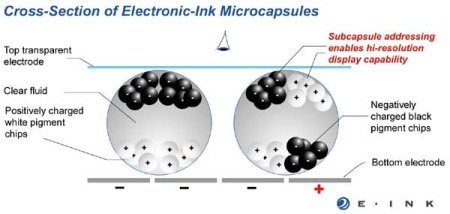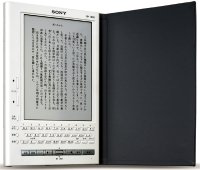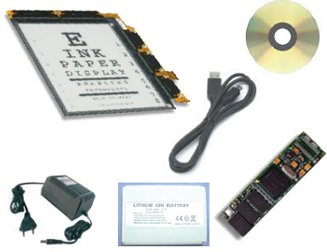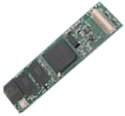Electronic paper development kit runs Linux
Sep 27, 2005 — by LinuxDevices Staff — from the LinuxDevices Archive — 60 views E Ink is preparing a Linux-based electronic paper development kit. The AM-100 EPD kit includes a 170dpi, 6-inch (diagonal) SVGA (800 x 600) “EPD” (electronic paper display) module supporting four shades of gray. The technology radically decreases display power requirements in mobile devices, the company claims.
E Ink is preparing a Linux-based electronic paper development kit. The AM-100 EPD kit includes a 170dpi, 6-inch (diagonal) SVGA (800 x 600) “EPD” (electronic paper display) module supporting four shades of gray. The technology radically decreases display power requirements in mobile devices, the company claims.
(Click for larger view of E Ink's “Osprey” phone prototype)
Electronic paper technology
According to E Ink, electronic paper offers a bright, high-contrast, thin, lightweight display technology that remains legible under “any lighting condition” — much like newsprint. Once an image has been “printed,” no power is needed to hold it, reducing energy requirements by 99 percent, compared to LCDs, for some applications, the company says.

E Ink's electronic paper is somewhat like a miniaturized Etch-a-Sketch based on electricity, instead of magnetism
 E Ink says its electronic ink display technology has already appeared in several products, including Sony's LibriE electronic book (pictured at right), available in Japan. Other early customers include Seiko, Citizen, and Microsoft, E Ink says. Early applications include watches, clocks, and signs, with smartcards, medical devices, portable consumer electronics, and mobile phones also expected to use the technology.
E Ink says its electronic ink display technology has already appeared in several products, including Sony's LibriE electronic book (pictured at right), available in Japan. Other early customers include Seiko, Citizen, and Microsoft, E Ink says. Early applications include watches, clocks, and signs, with smartcards, medical devices, portable consumer electronics, and mobile phones also expected to use the technology.
E Ink CEO Russ Wilcox said, “If your job is to design a product with a battery and a display, then you need to understand electronic paper.”
“Companies can move to bigger screens, and at the same time, reduce product weight because of the power savings,” added VP of sales Ryosuke Kuwada.
 In July, Fujitsu showed off what it claims is the world's first film-substrate-based bendable color electronic paper with an image memory. Fujitsu's color electronic paper consists of three displaying layers — red, blue, and green — and doesn't require color filters or polarizing layers, resulting a display that is “significantly more vivid than conventional reflective-type LCDs,” it said. Fujitsu hopes to commercialize it as soon as 2007.
In July, Fujitsu showed off what it claims is the world's first film-substrate-based bendable color electronic paper with an image memory. Fujitsu's color electronic paper consists of three displaying layers — red, blue, and green — and doesn't require color filters or polarizing layers, resulting a display that is “significantly more vivid than conventional reflective-type LCDs,” it said. Fujitsu hopes to commercialize it as soon as 2007.
Linux-based development kit
E Ink's development kit includes “everything needed” to prototype electronic book readers and other mobile devices, the company claims.

Electronic paper development kit
The EPD module included in E Ink's AM-100 kit is based on a piece of imaging film laminated to a glass-based TFT (thin-film transistor). The module is manufactured by Prime View International (PVI) of Taiwan, which will handle any high-volume purchases, E Ink says.
 In addition to an EPD, the AM-100 kit includes a Gumstix module. Gumstix modules are tiny SBCs (single-board computer) based on an Intel XScale PXA255 SoC (system-on-chip) processor, with on-board power supplies enabling them to be powered by batteries. I/O interfaces include BlueTooth, MMC, and USB.
In addition to an EPD, the AM-100 kit includes a Gumstix module. Gumstix modules are tiny SBCs (single-board computer) based on an Intel XScale PXA255 SoC (system-on-chip) processor, with on-board power supplies enabling them to be powered by batteries. I/O interfaces include BlueTooth, MMC, and USB.
The kit's SBC module comes preloaded with Linux and a variety of open source drivers and applications, E Ink says.
E-Ink senior electrical engineer Holly Gates said, “Most of our customers want to make working prototypes that are portable. So we put the control electronics onto a tiny board.”
This article was originally published on LinuxDevices.com and has been donated to the open source community by QuinStreet Inc. Please visit LinuxToday.com for up-to-date news and articles about Linux and open source.